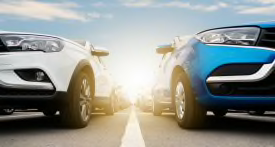The I-Pace marks a major turning point in Jaguar’s storied history. It’s a luxurious, fun-to-drive electric vehicle that’s also the first EV that can truly challenge Tesla’s mixture of technology and luxury. It has the potential of attracting luxury car buyers who aren’t necessarily EV adopters because of the Jag’s attractive interior, SUV-ish practicality, relatively long cruising range, and enjoyable driving experience. But the I-Pace is still limited by its long charging times, and it doesn’t have the benefit or convenience of an exclusive charging network like Tesla’s Superchargers.
The Jaguar feels like a conventional car built by a luxury car company, with its quiet cabin and luxurious, high-quality interior materials. This stands in contrast to Tesla models, whose material quality doesn’t match their price.
The Jaguar has sporty, agile handling, and it is thoroughly enjoyable to drive. However, its firm ride isn’t as cushy as it’s in traditional Jaguars. The brake pedal takes some getting used to: it’s either not responsive enough or too grabby, although that’s common in many electric or hybrid cars.
The I-Pace’s electric powertrain delivers smooth, instantly available acceleration. We clocked the Jaguar at a mere 4.3 seconds in our 0 to 60 mph acceleration test, which puts it in sports car territory.
But the car’s EPA-rated 246-mile range is less than that of some competitors from BMW and Mercedes and on par with the less-expensive Hyundai Kona EV or Kia Niro EV. The 90 kWh battery takes a long time to charge but that's par for the course. It's taken us about 13 hours to charge the I-Pace from nearly empty using a 240-volt charger. Still, owners who commute a modest distance shouldn't have as much recharging to make up when they get home, though cold weather and frequent stops can cut that range dramatically.
Jaguar drivers taking long trips must plan ahead and know in advance where a DC fast charger is located, and that might take them out of their way. This is a big difference from Tesla, which allows drivers to plot a long drive on its navigation system including stopovers to charge at Superchargers. Plus, the 100 kW max acceptance rate at public DC-fast chargers is behind the times.
The I-Pace is elegant and modern inside, with some conventional buttons and knobs for its controls. Thankfully the previously frustrating dual-screen infotainment system has been updated to Jaguar's latest infotainment system and in the process the climate controls have been converted from a touch screen back to knobs and buttons. We have used this system in other Jaguar Land Rover vehicles and while its layout is intuitive enough, the user is often met with considerable lag while trying to navigate through menus. The push-button gear selector is also tricky to use. We found the roomy front seats comfortable and supportive, even for long drives, and the rear seat is livable.
The I-Pace is a blend of sedan and SUV, not quite SUV tall, nor sedan low. On the plus side, the driver has a commanding view of the road in front and use of a practical hatchback. The hatch offers some practicality and there is a very small front trunk. On the downside, even with that front trunk there’s not much room for cargo, and rear visibility is compromised by the sloping roofline.
Standard advanced safety features include forward collision warning (FCW), automatic emergency braking (AEB), blind spot warning and rear cross traffic warning.


























